Electromagnetic Induction is a current produced due to the production of voltage (electromotive force) as a result of the changing magnetic field.
Table of Contents
Electromagnetic Induction is a current produced due to voltage production (electromotive force) as a result of a changing magnetic field. It is defined as the induction of an electromotive force by the motion of a conductor across a magnetic field or by a change in magnetic flux in a magnetic field.
| NCERT Books for NEET | NCERT Books for JEE Mains |
Also Check: NCERT Books - PDF Format for Classes 1 to 12
What is Electromagnetic Induction?
Electromagnetic Induction was discovered by Michael Faraday in 1831, and it was mathematically described as Faraday’s law of induction by James Clerk Maxwell.
Electromagnetic Induction is a process in which a conductor is put in a certain position and the magnetic field keeps varying or the magnetic field is stationary and a conductor is moving which produces a Voltage or EMF (Electromotive Force) across the electrical conductor. It is a current produced due to the voltage production (electromotive force) as a result of the changing magnetic field. This happens either when a conductor is kept in a moving magnetic field (when using an AC power source) or when a conductor is constantly in motion in a stationary magnetic field.
As per the setup given below, we can measure the voltage across the circuit through a conducting wire attached to a device. When a bar magnet is passed through the coiling, the voltage detector calculates the voltage in the circuit.
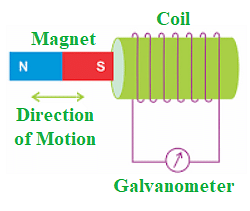
This experiment proved that there are certain factors that influence this voltage production as mentioned below:
- Number of Coils: The induced voltage is directly proportional to the total number of coils/turns of the wire. The greater the number of turns, the greater the voltage produced.
- Changing Magnetic Field: Induced voltage is affected by the changing magnetic field. This can be done either by moving the magnetic field around the conductor or moving the conductor in the magnetic field.
Also Check: NCERT Books for Class 12 Physics
Formula of Electromagnetic Induction
The significance of electromagnetic induction is the way in which electrical energy is produced in a circuit by using magnetic fields and not just batteries. Everyday machines like motors, transformers, and generators work on the principle of electromagnetic induction.
The induced voltage can be mathematically expressed by the following relation:
e = N × dΦ / dt
Where
e = induced voltage (in volts)
N = number of turns in the coil
Φ = magnetic flux - the amount of magnetic field at a surface (in Webbers)
t = time (in seconds)
Faraday’s Law of Electromagnetic Induction
Faraday’s Law of Induction also called Faraday's Law is a basic law of electromagnetism used to predict how a magnetic field will interact with an electric circuit to produce an electromotive force (emf). The two Faraday’s Law of Electromagnetic Induction are explained below:
- First Law: According to Faraday's Law, whenever a conductor is placed in a varying magnetic field, an electromotive force induces which is called an induced electromotive force. Also, if the conductor is a closed circuit, then the induced current flows through it.
- Second Law: The magnitude of the induced electromotive force is equal to the rate of change of flux linkages.
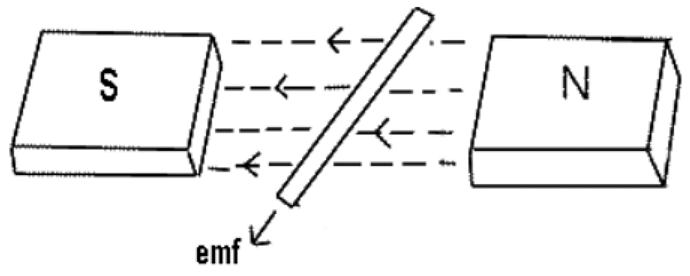
Lenz’s Law of Electromagnetic Induction
Lenz’s Law of Electromagnetic Induction states that when an EMF (electromotive force) induces according to Faraday’s Law, the polarity (direction) of that induced EMF opposes the cause of its production.
As per Lenz’s Law of Electromagnetic Induction
E = -N (dΦ/ dt) (volts)
Eddy Currents
As per Lenz Law of Electromagnetic induction, the electric current swirls in such a way that a magnetic field is created opposing the change. Due to its tendency to oppose, eddy currents cause a loss of energy. In this process, eddy currents transform more useful forms of energy, such as kinetic energy, into heat, which isn’t really useful. In most of the applications, the loss of useful forms of energy is not particularly desirable, but there are some practical applications that are listed below:
- Brakes of Trains: During braking, the brakes of some trains expose the metal wheels to a magnetic field which in turn generates eddy currents in the wheels. The magnetic interaction between the eddy currents and the applied field slows down the wheels. The faster the wheels spin, the stronger is the effect. This means that as the train slows down, the braking force is reduced, thus producing a smooth stopping motion.
- There are a few galvanometers that have a fixed core of nonmagnetic metallic material. When the coil oscillates, an eddy current is generated in the core which opposes the motion and brings the coil to rest.
- Induction furnace is used to prepare alloys, by melting the metals. The eddy currents generated in the metals produce high temperature which is enough to melt it.
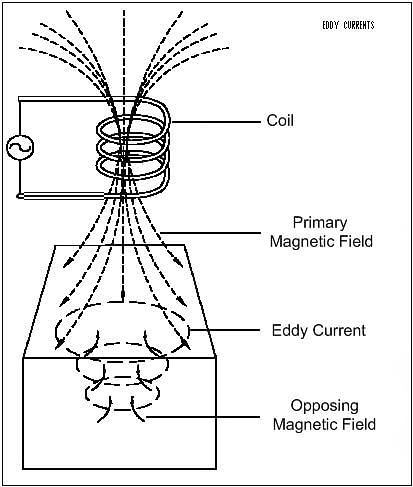
Applications of Electromagnetic Induction
Based on Michael Faraday’s experiments, we have Faraday’s law, according to which the amount of voltage induced in a coil is proportional to the number of turns of the coil and the rate of changing magnetic field. Listed below are some of the applications of electromagnetic induction:
- Electromagnetic Induction in AC Generator
- Electrical Transformers
- Magnetic Flow Meter
Electromagnetic Induction in AC Generator
Electromagnetic induction is used in the generation of alternating current (AC).
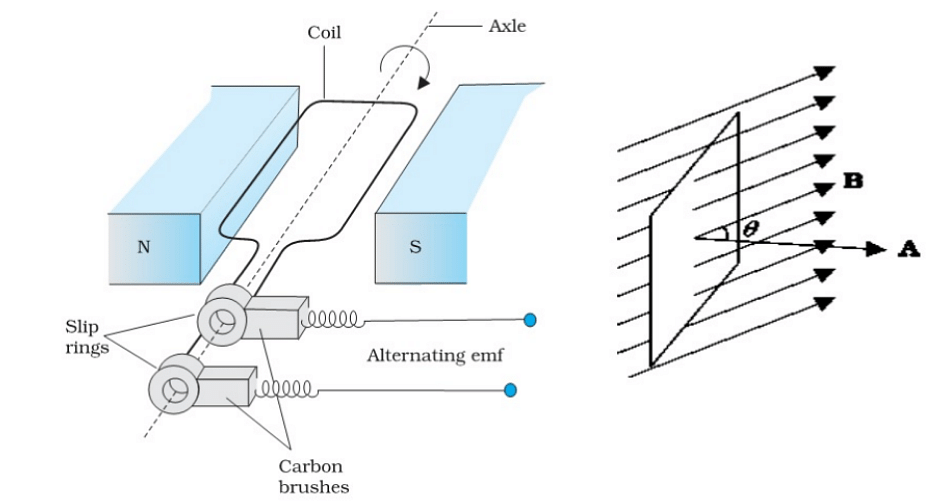
Consider a more evolved AC generator with an output capacity of 100 MV. As the coil rotates in a magnetic field B, the effective area of the loop is A cosθ, where θ = angle between A and B. This method of producing a flux change is the principle of operation of a simple AC generator. Here, the axis of the rotation coil is perpendicular to the direction of the magnetic field. The rotation of the coil causes the magnetic flux through it to change, so an EMF (electromotive force) keeps inducing in the coil.
Electrical Transformers
Another important application of electromagnetic induction is the working of an electrical transformer. An electric transformer is a device that changes AC electric power at one voltage level to another voltage level through the action of a magnetic field. A step-down transformer is a transformer in which the voltage is higher in the primary voltage than the secondary voltage. Whereas the transformer in which the secondary voltage has more turns is called a step-up transformer. Power companies generally use a step-up transformer to boost the voltage to 100 kV, which in turn reduces the current and minimizes the loss of power in transmission lines. Household circuits, on the other hand, use step-down transformers to decrease the voltage to 120 or 240 V in them.
Magnetic Flow Meter
The working of magnetic flow meters is based on Faraday’s Law of Electromagnetic Induction. A voltage E is generated when a conductive medium passes through a magnetic field B. This voltage is proportional to the velocity v of the medium, the length of the conductor and the density of the magnetic field.

In a magnetic flow meter, a current is applied to wire coils mounted inside or outside the meter body to generate a magnetic field. The liquid which flows through the pipe acts as the conductor thus inducing a voltage which is proportional to the average flow velocity. This voltage is determined by the sensing electrodes that are mounted in the Magflow meter body and sent to a transmitter which calculates the volumetric flow rate based on the pipe dimensions.
Mathematically, Faraday’s law can be stated as
E ∝ V x B x L
Where E is the voltage generated in a conductor, V is the velocity of the conductor, B is the magnetic field strength and L is the length of the conductor.
FAQs on Electromagnetic Induction
Q1: Define Electromagnetic Induction.
Ans: Electromagnetic Induction is defined as the current produced due to voltage production (electromotive force) as a result of changing magnetic field.
Q2: Who discovered Electromagnetic Induction?
Ans: Michael Faraday discovered Electromagnetic Induction in 1831.
Q3: What is the significance of Electromagnetic Induction?
Ans: The significance of the discovery of Electromagnetic Induction is a way in which electrical energy is produced in a circuit by using magnetic fields and not just batteries.
Q4: Which machines work on the principle of Electromagnetic Induction?
Ans: Some of the machines that work on the principle of Electromagnetic Induction are everyday machines like motors, generators and transformers.
Q5: What are the applications of Electromagnetic Induction?
Ans: Some of the applications of Electromagnetic Induction are as follows:
- Alternating current generators (AC generators) work on the principle of electromagnetic induction
- Electrical transformers work based on electromagnetic induction
- The principle of magnetic flow meter is based on electromagnetic induction
Q6: What are the Uses of Electromagnetic Induction?
Ans: Electromagnetic Induction is used in devices such as Current clamps, Electric generators, Electromagnetic forming, Hall effect meters, Induction cooking, Induction motors, Induction sealing, Induction welding, Inductive charging, Inductors, Graphics tablets, Magnetic flow meters, Mechanically powered flashlight, Pickups, Rowland ring, Transcranial magnetic stimulation, Transformers, and Wireless energy transfer.

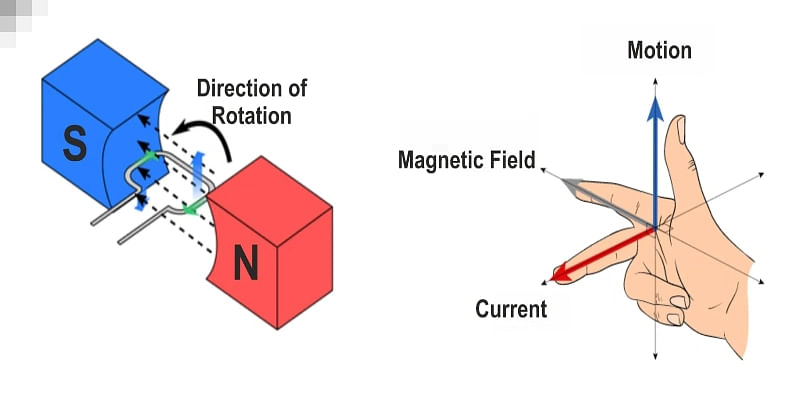












POST YOUR COMMENT